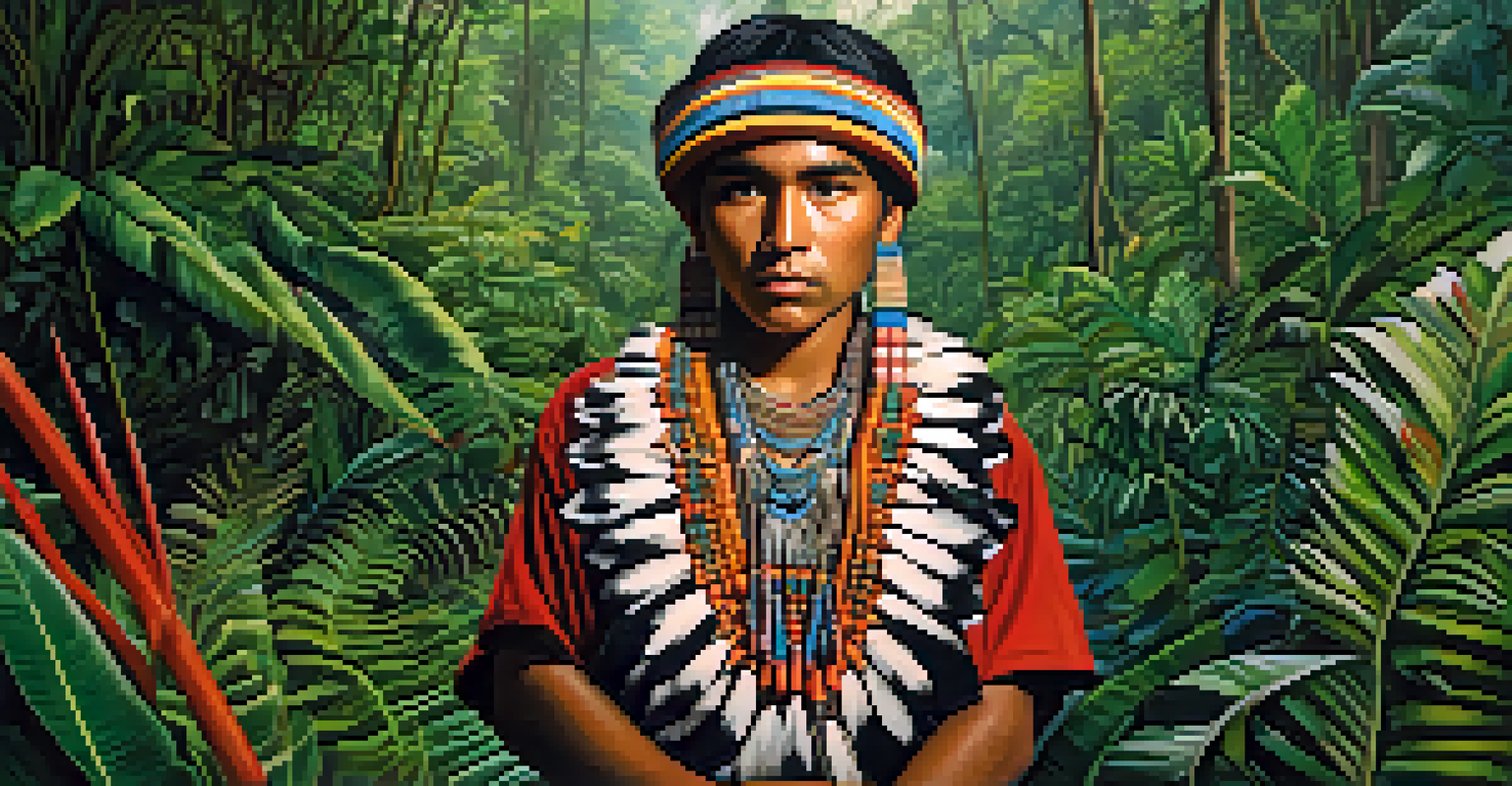The Amazon: Historical Narratives and Eco-Tours in Brazil

The Amazon: A Historical Overview
The Amazon rainforest, often referred to as the lungs of the Earth, has a rich historical tapestry. This vast ecosystem has been home to countless indigenous tribes for thousands of years, each with their own unique cultures and traditions. Their stories, intertwined with the land, reveal a deep connection and respect for nature that is vital to understanding the Amazon's significance today.
The greatest threat to our planet is the belief that someone else will save it.
European exploration in the 16th century marked a turning point in the Amazon's history, leading to the exploitation of its resources and peoples. The arrival of colonizers brought both goods and diseases that decimated indigenous populations and altered the landscape. This history of conflict and resilience showcases the Amazon as a battleground of cultures and a repository of ancient knowledge.
Today, the Amazon's historical narratives are not just tales of the past but are essential for eco-tourism initiatives. Understanding this history enhances our appreciation for the region and encourages sustainable practices that honor both the environment and its original stewards.
The Indigenous Peoples of the Amazon
The Amazon is home to over 350 indigenous groups, each with its own language, customs, and spiritual beliefs. These communities have thrived in harmony with the forest, relying on its resources for food, shelter, and medicine. Their deep-rooted knowledge of the ecosystem is invaluable for conservation efforts and teaches us the importance of biodiversity.

Many indigenous peoples are now harnessing eco-tourism to share their culture and protect their lands. By inviting travelers into their communities, they offer unique experiences that highlight traditional practices, such as hunting, fishing, and crafting. This not only generates income but also fosters respect and understanding between visitors and local cultures.
Rich History of the Amazon Rainforest
The Amazon has a deep historical connection with indigenous peoples, whose cultures and traditions are vital for understanding the region's significance today.
However, these communities face challenges from deforestation and encroachment on their territories. Supporting indigenous-led eco-tourism initiatives can empower these groups and ensure their voices are heard in the conversation about land preservation and cultural heritage.
Eco-Tourism: A Sustainable Approach
Eco-tourism in the Amazon combines adventure with environmental responsibility, allowing travelers to appreciate the rainforest without harming it. Activities like guided hikes, wildlife spotting, and canoeing through the waterways provide immersive experiences that connect visitors to the natural world. This form of tourism promotes conservation and helps protect the delicate balance of the ecosystem.
In every walk with nature one receives far more than he seeks.
Many eco-tours are run by local communities, ensuring that a significant portion of the revenue stays within the region. This model not only supports local economies but also encourages the preservation of traditional lifestyles and knowledge. As travelers learn about the environment, they also contribute to the sustainability of the very landscapes they explore.
Furthermore, eco-tourism raises awareness about the environmental issues facing the Amazon, from deforestation to climate change. By engaging with these topics, tourists can become advocates for the protection of the rainforest, spreading the message long after their journey ends.
Flora and Fauna: The Amazon's Biodiversity
The Amazon rainforest is one of the most biodiverse places on Earth, home to millions of species of plants and animals. From vibrant orchids to majestic jaguars, the sheer variety of life is astounding. This biodiversity is crucial for maintaining the ecological balance and provides essential resources for indigenous peoples and modern medicine alike.
Exploring the Amazon allows visitors to witness this incredible diversity firsthand. Guided tours often include stops at unique ecosystems, such as flooded forests or terra firme, where tourists can observe rare species in their natural habitats. These experiences not only create lasting memories but also foster a deeper understanding of the interconnectedness of life.
Biodiversity and Eco-Tourism
The Amazon's incredible biodiversity supports both conservation efforts and eco-tourism, allowing travelers to engage with the environment responsibly.
However, this remarkable biodiversity is under threat from human activities like logging and agriculture. Eco-tourism plays a vital role in highlighting the importance of conservation efforts and can inspire visitors to take action in their own communities to protect the environment.
The Role of Conservation in Eco-Tourism
Conservation is at the heart of eco-tourism, as it aims to protect the natural environment while providing economic benefits. In the Amazon, many eco-tourism initiatives work alongside conservation organizations to create protected areas and restore damaged ecosystems. This collaboration ensures that the tourism industry supports rather than undermines the region's ecological integrity.
Tourists play a crucial role in this process by choosing eco-friendly tours and supporting businesses that prioritize sustainability. By opting for responsible travel practices, individuals can contribute to conservation efforts and help mitigate the impact of tourism on the environment. It’s a win-win situation where both nature and travelers benefit.
Moreover, conservation-focused eco-tourism raises awareness about environmental issues and encourages visitors to advocate for the protection of the Amazon long after their trip. This ripple effect can lead to widespread support for initiatives aimed at preserving the rainforest and its diverse inhabitants.
Challenges Facing Eco-Tourism in the Amazon
Despite its potential, eco-tourism in the Amazon faces several challenges that threaten its success. Issues like deforestation, illegal mining, and climate change pose significant risks to the region's biodiversity and cultural heritage. As these challenges grow, so does the need for responsible tourism practices that prioritize environmental and social integrity.
Additionally, the COVID-19 pandemic has highlighted the vulnerability of the eco-tourism sector. Many businesses relying on tourism experienced significant declines, leading to economic hardships for local communities. This situation emphasizes the importance of resilience and adaptability in the face of unforeseen challenges.
Challenges to Eco-Tourism
Despite its potential, eco-tourism in the Amazon faces significant challenges such as deforestation and the impacts of climate change, necessitating sustainable practices.
To overcome these hurdles, collaboration between governments, local communities, and tourists is essential. Supporting eco-tourism initiatives that are truly sustainable can help ensure that the Amazon's treasures are preserved for generations to come.
Experiencing the Amazon: What to Expect
Traveling to the Amazon is an adventure like no other, filled with opportunities for exploration and discovery. Visitors can expect to immerse themselves in a lush environment teeming with life, where every turn may reveal a new wonder. Whether it's spotting a rare bird or listening to the sounds of the forest, the experiences are unforgettable.
Many eco-tours offer unique accommodations, such as jungle lodges or floating hotels, allowing travelers to fully embrace the natural surroundings. Guided excursions often include activities such as night walks, canoe trips, and cultural interactions with indigenous peoples. Each activity is designed to educate and inspire, fostering a greater appreciation for the Amazon's beauty and complexity.

Ultimately, a journey to the Amazon is not just a vacation; it's an opportunity to connect with nature, learn about diverse cultures, and contribute to the protection of this vital ecosystem. As travelers return home, they carry with them stories and insights that can spark conversations about the importance of conservation and sustainable practices.